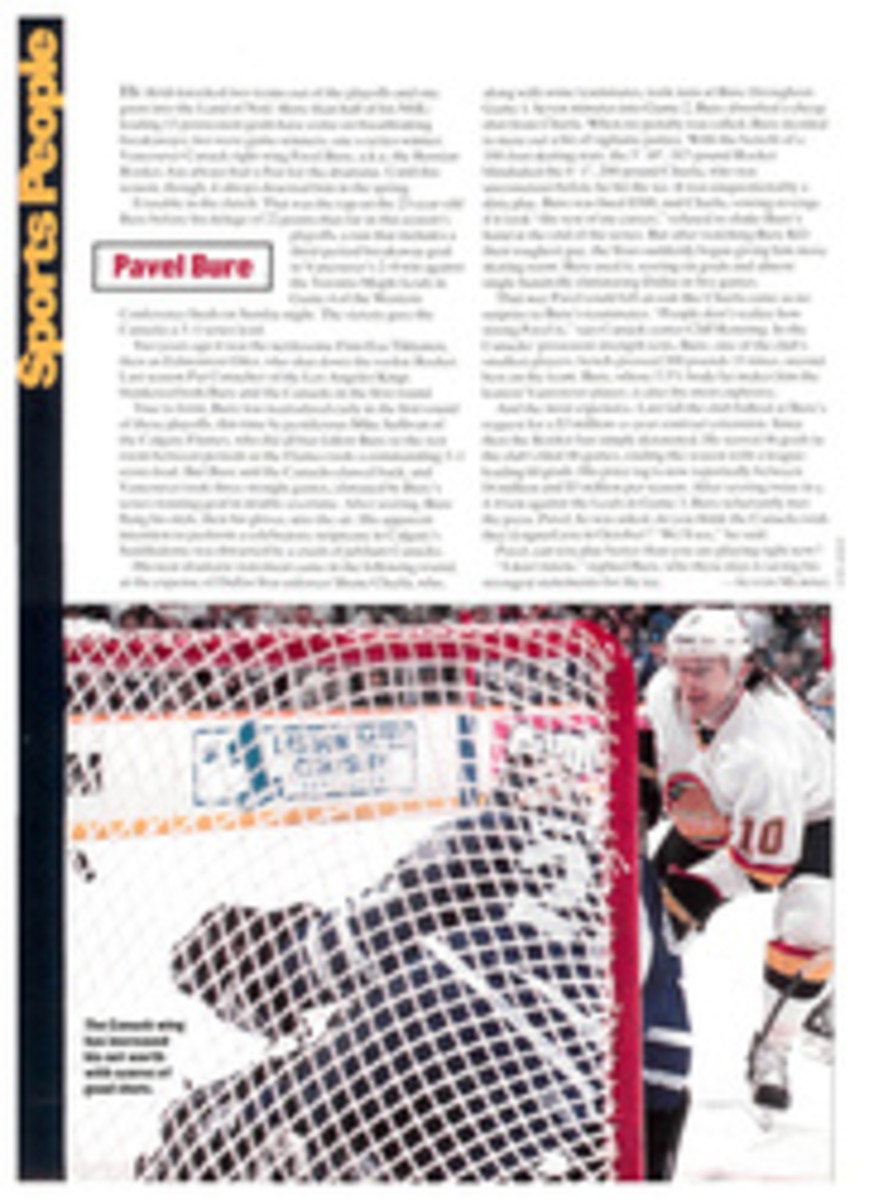
Her Not So Serene Highness
Ask Kitty Calhoun Grissom why she does what she does, and you get the sort of answer you might expect from a bicycle messenger. "I'd get bored," she says in her Southern drawl, "if I did a regular job."
She would indeed. Grissom, 33, is one of the world's most-accomplished Alpine climbers, having led expeditions up two of the highest peaks on earth. In 1987 she became the first American woman ever to reach the top of Dhaulagiri, a 26,795-foot Himalayan mountain whose summit is the seventh highest in the world. Three years later she became the first woman and—with her climbing partner—one of only six people to stand atop another lofty Himalayan mountain, 27,766-foot Makalu, the fifth-highest peak on earth, after reaching it via the West Pillar.
Last summer Grissom attempted to climb the North Ridge of Latok I, a mountain in the Karkarom range of Pakistan. This route is so technically challenging—although, at 23,440 feet, the summit is not exceptionally high—that it had never been climbed completely in live previous attempts. Grissom's expedition made the total six. For 17 days her four-person team was stopped by unrelenting bad weather, and then they were forced to descend. Further, team member Colin Grissom, Kitty's husband, needed to return to the U.S. to take his medical boards. "It's hard if you don't make a route," says Kitty, whose laid-back demeanor begins to fade as the air grows thinner. "But it would be harder if you'd never made one."
For Grissom to be derailed in a quest, it usually takes an act of God. "What sets her apart," says Matt Culberson, a Salt Lake City climber and a member of the Dhaulagiri expedition, "is her incredible drive." Not that it's always good, he adds. "Sometimes, in Kitty, I think it's tunnel vision. But I also think that's what you need to make it up the mountain."
Grissom, 5'3" and 118 pounds, spent her early 20's learning to climb in ice and snow, and she has been attempting some of the world's most technically challenging ascents ever since. "There are just a handful of women around the world who are on the cutting edge of the most difficult climbs—Kitty, [American rock climber] Lynn Hill and [French Alpine climber] Catherine Destivelle," says Yvon Chouinard, a veteran climber and the CEO of Patagonia, the outdoor-clothing manufacturer. And among male climbers, says Alison Osius, a senior editor at Climbing magazine, "Kitty's considered a peer."
Alpine climbing is a combination of rock, ice and snow climbing. The mountain faces favored by Alpine climbers are steep and dangerous, and sometimes the climbers require extra oxygen. Grissom's team members climb with crampons on their feet, ice axes in their hands and, usually, tents, sleeping bags, food and fuel on their backs. Their safety net is a rope anchored intermittently to rock or ice. Their camps—on the final ascent, at least—are often ledges no wider than a compact car.
Grissom was born in Greenville, S.C. Her father is a corporate lawyer and a descendant of John C. Calhoun, a U.S. vice president under both John Quincy Adams and Andrew Jackson. Grissom's parents, who are now divorced, taught her and her three siblings to be unfailingly polite and sent them to private schools. The Calhouns also encouraged their children to excel in sports. "Still, there's no explaining her attraction to extremes," says O.G. (Tuck) Calhoun of his eldest daughter. "The only thing I can think of is that a first cousin on her mother's side was a tightrope walker with the Wallendas."
A skier since the age of four, Kitty took up climbing at 18 after participating in a monthlong Outward Bound course in North Carolina. At the University of Vermont she traded her ski boots for climbing shoes and became, as she says, "a climbin' bum" with a passion for the sport's most difficult surface: ice. "It's real pretty out there in the winter, and there are not as many people around," she says, explaining the lure of ice. "Besides, it seemed adventurous."
After graduating from Vermont in 1982, she packed her station wagon and headed for Colorado. She was determined to spend only $3,000 a year (including $14 a week for food) while she honed her climbing skills.
For the next six years she traveled around the West, working part time as a guide and instructor for Outward Bound and a mountain guide for the American Alpine Institute and living out of her car. When she wasn't working, she teamed up with anyone who was interested in challenging climbs—mostly men—and pushed herself to keep up with them. "You didn't see many women ice climbing," says Andy Selters, an outdoors photographer and writer who first climbed with Kitty in Montana in 1984. "And it was obvious she was a bold climber." Too bold, in some people's minds, it turns out. "We were all surprised that she wasn't killed," says Culberson.
As Kitty waxes on like a latter-day Thoreau about her itinerant existence, her husband feels compelled to interject facts. "Yeah," he points out to a visitor, "but Kitty had mice living in her car."
"Occasionally, Colin," Kitty replies.
The lean years, mice and all, have influenced the way Grissom plans her ascents. In an age when glitzy Everest expeditions run up bills of a quarter of a million dollars, Grissom's small teams usually spend $4,500-$5,000 per person. She cuts costs by bringing only the bare minimum in equipment. "On those dangerous mountains," says Chouinard, "the less time you spend up there, the safer you are. It's actually much safer not to take extra things—and to move quickly—than to take everything just in case."
On occasion, however, Grissom has erred on the side of austerity. During the Dhaulagiri expedition she forbade her team to carry chairs for base camp, and she brought only two 300-foot ropes for the attack on the peak. "People laugh at us now," says Culberson, "because everyone knows you need at least 1,000 feet of rope for a Himalayan expedition." Grissom says, however, that it was unexpected difficulties that led them to cooperate with a Japanese team and a Spanish team.
Still, even that cooperation couldn't stop Kitty, Colin and John Culberson (Matt's brother) from nearly perishing in an avalanche as Matt watched from below. Midway up Dhaulagiri's northeast ridge, Colin was leading the team along a wind slab (a dense layer of snow resting on a less tightly packed layer), following a fixed rope that a Japanese team had used the day before. "I remember thinking that this wasn't a good place to cross," says Colin, a former All-America wrestler at Yale and now a specialist in pulmonary medicine, "but you think, The Japanese went across, it must be O.K. And that was the wrong thing to think." When Colin took his second step on the gentle slope, the ground beneath him collapsed, triggering an avalanche. As the three climbers tumbled 500 feet through ice and snow, the anchors holding the rope snapped one by one. Only the eighth—and last—anchor held. Colin suffered a stretched ligament in his right knee; John had a sprained ankle; and Kitty had a gash in the crook of her left elbow from rope burn. "The rope tore through three layers of polypropylene and one of Gore-Tex," she says. Despite their injuries, the three reached the summit 16 days later.
Climbers call these sorts of crises epics, something to brag about after they have safely reached base camp. Kitty has had a number of them. In 1985 she and Colin were attempting to cross Mount McKinley's difficult Cassin Ridge when they were trapped for five days by a snowstorm, with no food and with enough fuel to melt only a pint of water each day. When the snow finally stopped and the two of them eventually reached a medical camp, says Kitty, "Colin ate continuously for 16 hours."
While the epics—and the deaths of half a dozen experienced Alpinists in recent years—have given Kitty pause, she insists she isn't ready to put up her crampons. But there are signs that Kitty is settling down. She and Colin, who were married in 1988, recently bought a three-bedroom house in Salt Lake City. And, after receiving an M.B.A. from the University of Washington last year, Kitty has thrown her considerable energy into Exum Mountain Adventures, her guiding company in Salt Lake City, leading people on local rock-and ice-climbing trips and backcountry skiing tours.
At the moment Kitty doesn't have her sights on any heart-stopping ascent, but it is difficult to imagine her staying near sea level for long. "I like mountains that are real pointed and symmetrical and routes that are real straight up, that just stand out and are technically challenging," she says. "Just putting one foot in front of the other isn't for me."
PHOTO
MARK HOUSTON
In 1990 on Makalu, Grissom became one of only a few Alpinists to succeed via the West Pillar.
TWO PHOTOS
ANDY SELTERS
On Pakistan's Thelay Sagar, Grissom (left) and a pal sat out a storm and many avalanches for eight days.
Laura Hilgers is a freelance writer who lives near sea level in San Francisco.

